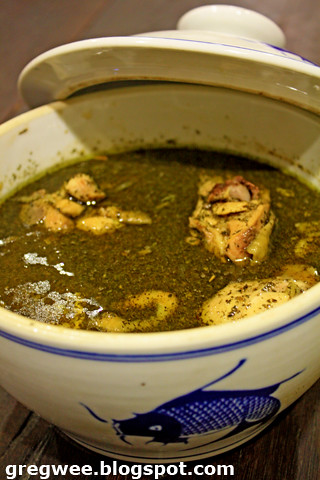I do not know where kacama originates from, nor does my mum nor my grandaunt. My guess is that since it's a herbal-based dish, it could probably have come from the Hakkas. The Hakkas are well known for their Lui Cha & their tradition of pepper farming (at least in Sarawak).Not quite sure whether the herbs is similar to those of a pepper tree. Anyone?
But kacama has always been a dish to be served after child birth. The kacama herbs are sometimes referred to as Yie Mu Chao (Benefit Mother Grass) and they are harvested and dried before bottling or more commonly nowadays in packets. Along with Chicken Wine Soup and Pig's kidney and liver with lots of ginger, this is a very famous dish in Sarawak with the exception of Sibu to be taken to clean the womb and to rid of any blood clots after child birth. It has a warming effect, which is good for the new mother. Besides that, young girls who has tummyache during period can take this rich broth to improve their womb conditions as it is belived that tummyache is a sign of not so strong womb.
For us like many Sarawakians, we always like kacama for its fragrance & the spicy kick from the wine & the ginger. Kacama nowadays can be found in many fast food stalls just like any normal dish but it is usually very diluted. Cooking kacama is not difficult at all but a good kacama dish is not easy to cook, for it is the product of a perfect simbiosis between the right amount of wine, with the right amount of ginger, with the right amunt of herbs and chicken.
What you will need: 1 packet of kacama herbs.
This is actually the most difficult process of cooking this dish.
The first concern is about buying the herbs, available at most markets in Kuching. This herb is plentiful but choosing a packet that is fresh, which means looking green, not brownish, is important. Check that there are minimum stalks in the packet. If there are too many stalks, then the packet generally will have less leaves and it is the leaves that we want.
Then comes the treating process.
1) Place herbs in a small wok/pan. With low to medium fire, slowly dry stir fry the herbs to brown. If you undercook the herbs, the dish will have a leafy taste. If you use too high a fire, you risk burning the herb and that brings a bitter taste to the dish. The process of stir frying must be slow and would usually take up to 1/2 hour of continued stirring and controlling of fire until the herbs turn dry (it will crackle up upon pressing with two finger) and greenish brown up and release a special fragrance. You should not see fresh green leaves at all.
2) Blend the greenish brown up herbs till fine and sift to rid of any stalks. The stalks if included into the dish is pretty annoying to bite and we want our kacama smooth. Store in airtight container for further usage.
1/2 no of chicken or 2 no of thigh meat, weighing about 1 kg
100-120gm of local ginger (less if you are not a ginger person)
4tbsp of treated kacama herbs
1 cup of chinese white wine
1/2 cup of chinese glutinous rice wine (optional or if you like a wine spicy dish use 1 1/2 cup of white wine in total)
3-4 tbsp of sesame oil
1) Clean and rid the ginger off the skin. Pound till fine with pestle and mortar. Squeeze the juice and set aside.
2) Heat the wok and slowly stir fry the ginger pulps with sesame oil till fragrant. Add chicken and continue stir frying till chicken pieces turn white.
3) Add herbs and coat all meat with herbs.
4) Add the two wine and ginger juice and transfer the dish to a chinese double boiler and double boil for 40 - 50 mins or till the meat is cooked thoroughly and fully absorbs the wine.
Note:
We do not want meat so soft that it falls apart. That would mean that the soup has absorbed all the chicken flavour and the chicken is basically redundant and tasteless. The dish needs to be eaten meat and soup together. The cross balancing of meat with wine and herbs flavour, with chicken flavour in the soup is very important.
If cooking is done in a normal pot in braising style, add only half of the wine and cook for 30 - 40 mins. Add the other half portion of the wine 10 min before turning off the fire. Braising style tends to boil the dish up a little too much and evaporates the wine much more compared to double boiling. If you want to tone down the wine, then you can follow step 4 in the braising style and cook for roughly 30- 40 mins.
It is a dish you either love or hate. But most Sarawakians like our affection for our Laksa tend to have own respective favourite taste to this dish. Some like it diluted with less wine spike, we like is with a lot of wine spike and a slight sweet notation (hence the glutinous wine step) and others love it so spicy they just really spicy white wine. Adjust the recipe to your liking. Serve with a bowl of nice fragrant jasmine rice. Yum!

